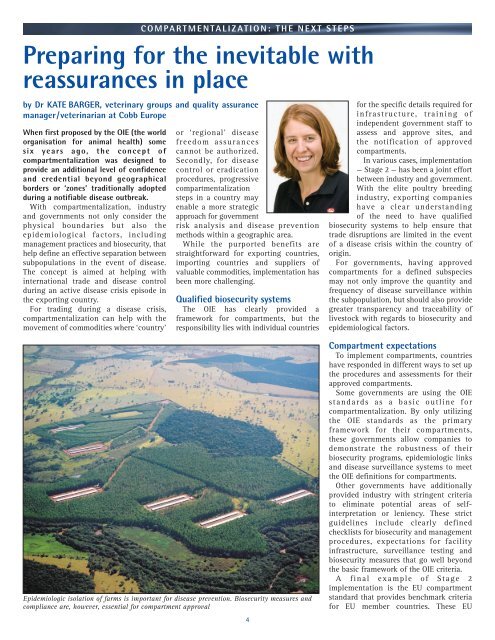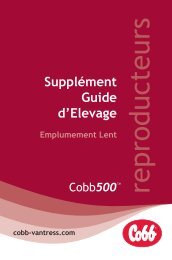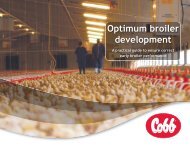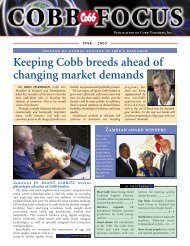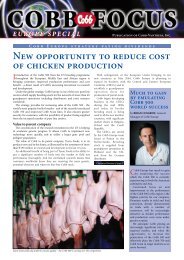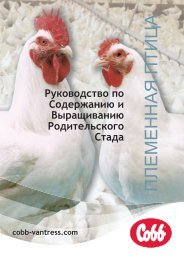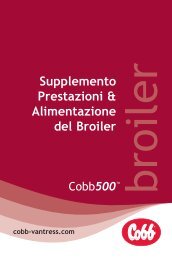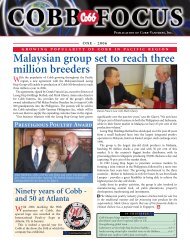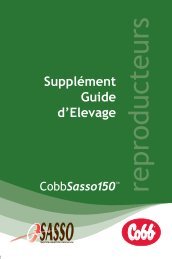Cobb Focus Three 2011 (English)
Cobb Focus Three 2011 (English)
Cobb Focus Three 2011 (English)
Create successful ePaper yourself
Turn your PDF publications into a flip-book with our unique Google optimized e-Paper software.
When first proposed by the OIE (the worldorganisation for animal health) somesix years ago, the concept ofcompartmentalization was designed toprovide an additional level of confidenceand credential beyond geographicalborders or ‘zones’ traditionally adoptedduring a notifiable disease outbreak.With compartmentalization, industryand governments not only consider thephysical boundaries but also theepidemiological factors, includingmanagement practices and biosecurity, thathelp define an effective separation betweensubpopulations in the event of disease.The concept is aimed at helping withinternational trade and disease controlduring an active disease crisis episode inthe exporting country.For trading during a disease crisis,compartmentalization can help with themovement of commodities where ‘country’C O M P A R T M E N T A L I Z A T I O N : T H E N E X T S T E P SPreparing for the inevitable withreassurances in placeby Dr KATE BARGER, veterinary groups and quality assurancemanager/veterinarian at <strong>Cobb</strong> Europeor ‘regional’ diseasefreedom assurancescannot be authorized.Secondly, for diseasecontrol or eradicationprocedures, progressivecompartmentalizationsteps in a country mayenable a more strategicapproach for governmentrisk analysis and disease preventionmethods within a geographic area.While the purported benefits arestraightforward for exporting countries,importing countries and suppliers ofvaluable commodities, implementation hasbeen more challenging.Qualified biosecurity systemsThe OIE has clearly provided aframework for compartments, but theresponsibility lies with individual countriesfor the specific details required forinfrastructure, training ofindependent government staff toassess and approve sites, andthe notification of approvedcompartments.In various cases, implementation— Stage 2 — has been a joint effortbetween industry and government.With the elite poultry breedingindustry, exporting companieshave a clear understandingof the need to have qualifiedbiosecurity systems to help ensure thattrade disruptions are limited in the eventof a disease crisis within the country oforigin.For governments, having approvedcompartments for a defined subspeciesmay not only improve the quantity andfrequency of disease surveillance withinthe subpopulation, but should also providegreater transparency and traceability oflivestock with regards to biosecurity andepidemiological factors.Epidemiologic isolation of farms is important for disease prevention. Biosecurity measures andcompliance are, however, essential for compartment approval4Compartment expectationsTo implement compartments, countrieshave responded in different ways to set upthe procedures and assessments for theirapproved compartments.Some governments are using the OIEstandards as a basic outline forcompartmentalization. By only utilizingthe OIE standards as the primaryframework for their compartments,these governments allow companies todemonstrate the robustness of theirbiosecurity programs, epidemiologic linksand disease surveillance systems to meetthe OIE definitions for compartments.Other governments have additionallyprovided industry with stringent criteriato eliminate potential areas of selfinterpretationor leniency. These strictguidelines include clearly definedchecklists for biosecurity and managementprocedures, expectations for facilityinfrastructure, surveillance testing andbiosecurity measures that go well beyondthe basic framework of the OIE criteria.A final example of Stage 2implementation is the EU compartmentstandard that provides benchmark criteriafor EU member countries. These EU


